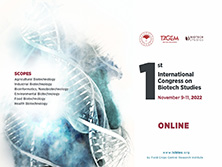Biotech Studies
2017, Vol 26, Num, 3 (Pages: 099-104)
Yield and Essential Oil Characteristics of Clones Derived From Common Sage (Salvia officinalis L.) Population
2 Süleyman Demirel Üniversitesi, Ziraat Fakültesi, Tarla Bitkileri Bölümü, Isparta DOI : hasanbaydar@sdu.edu.tr - In this study, various characteristics of 60 A type sage clones obtained by selection process starting from a spontaneous common sage (Salvia officinalis L.) population were investigated for drug leaf yield, essential oil content and composition. The ranges of the clone mean values were obtained for drug leaf yield as 45.6 and 188.4 kg da-1 in 2011, and 26.4–638.0 kg da-1 in 2012 growing season, and for essential oil content as 0.60 and 1.90% in 2011 and 1.11–2.53% in 2012 growing season, respectively. In the sage clones analysed, the most important essential oil compounds determined were α-and β-thujone, 1.8-cineole and camphor. In 2011 growing season, the contents of these volatiles were the following: α-thujone, 0.8–29.5%; β-thujone, 0.7–29.1%; 1.8-cineole, 1.0–30.5% and camphor, 0.4–19.1%. In 2012 the chemical distributions were α-thujone, 1.0–53.2%; β-thujone, 2.2–54.7%; 1.8-cineole, 2.8–34.0% and camphor, 6.4–29.2%. Considering the drug leaf yield, volatile oil content and quality, 10 different clones out of 60 A clones (3, 8, 11, 14, 21, 26, 27, 35, 41 and 51) were chosen and will be advanced to B clones in repetitive yield experiments for further evaluation. Keywords : Common sage, clonal selection, drug yield, essential oil content and compounds















